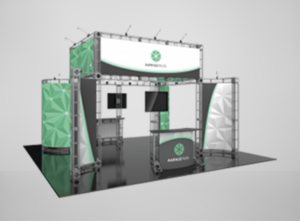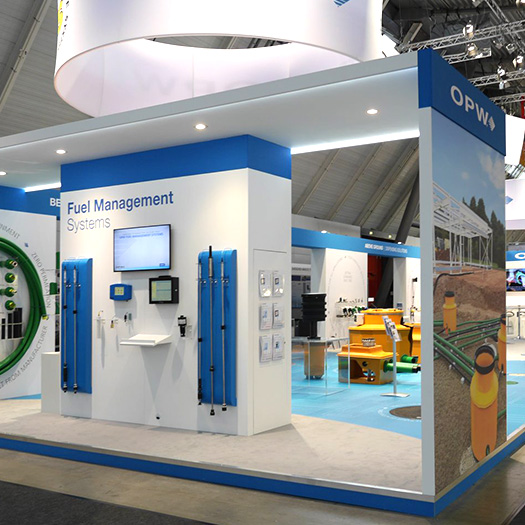The Qualified Lead: the Holy Grail of the Trade Show
Published on June 4th, 2019
in Uncategorized
How the right show, the perfect booth, and asking meaningful questions can make all the difference in the world.

Trade shows - they’re a significant investment of time, energy, and money. And let’s face it: the real reason we put so much into them is because we want something out of them — namely strong, qualified leads that will ultimately convert to a customer and to a sale.
At a given show, you may get hundreds or even thousands of guests at your booth. So how do you weed out potential prospects from those that are just looking for a free stress ball or keychain? It’s all about taking a logical approach, and it starts before the show.
Find the right shows for your business.
Too often, companies will attend a trade show because they think they need to be there. But just because you’ve always gone to an industry show - or just because your competitors go - is not a good reason for you to attend. You want to go to the shows where your potential customers will be going. Most show organizers will provide you with profiles of attendees, so you can check far in advance to make sure a particular show is worth your time and expense. By narrowing the field before the show, you’ll have much better luck of meeting qualified leads at the show.
And it’s not always the biggest shows that yield the best return. For many companies, smaller, more intimate shows provide a better opportunity for personal interaction with prospects, and often are much more affordable to attend. And if you find the big shows are indeed where you need to be, do your best to get a good spot. You’ll get much more traffic if you’re right off the escalator than if you’re tucked away in the back corner.
 Keep your booth simple and on-brand.
Keep your booth simple and on-brand.
Your booth matters. It needs to look both professional and visually appealing. But most importantly, it needs to quickly and clearly convey your brand or product’s value proposition. Don’t try to cram too much information on your booth: excessive text and imagery is confusing. Rather, create a message that makes attendees want to know more about what you do.
Learn to spot the tire kickers.
You see them at every trade show: people going around filling up on free swag, with absolutely no intention of having a meaningful discussion with anyone. You can usually identify them pretty quickly – about half a minute into the conversation. Just accept the fact that they are part of the trade show world, and have lines prepared to politely dismiss them so you can focus your energy on those who really want to engage with you.
The right questions start with sales.
So you’re at the show and you’re talking to someone who seems like he or she could be the real deal. It’s time to start asking questions to see if this is truly a qualified lead.

Long before the show, prepare a series of questions with your sales team. Why sales? They’re the ones who best know what your customers want, what they don’t want, and how the react to certain types of situations. Tap into their wisdom. After all, if a prospect doesn’t meet the sales team’s criteria, they won’t even follow up after the show.
Also, review the “performance” of questions you’ve asked in the past. Were they helpful? If not, scrap them. Were some key areas missed? Once you have your final list of questions, again review with sales— and even current customers — to prioritize your questions in the most logical way. Your existing clients are a great resource that should be tapped whenever possible.
After you gather feedback from sales and customers, fine-tune your questions. If they are multiple choice, take care to craft the possible answers in ways that really communicate something that makes you better. For example, the question might be, “What do look for when choosing a [product]?” One of your multiple choice answers should include a benefit you offer, such as “A significant reduction of down time.” In this way, you can lead your prospects towards the conclusion that your product or service is superior.
Keep it real.
People want to be treated like people. Be friendly. Be conversational. Find out what they need. What are their pain points? What problems are they trying to solve? Don’t just talk about what your company does or how great your products are. Learn what your prospects are looking for, and you’d be surprised how quickly you can turn them into a genuine qualified lead.
 Trade shows - they’re a significant investment of time, energy, and money. And let’s face it: the real reason we put so much into them is because we want something out of them — namely strong, qualified leads that will ultimately convert to a customer and to a sale.
At a given show, you may get hundreds or even thousands of guests at your booth. So how do you weed out potential prospects from those that are just looking for a free stress ball or keychain? It’s all about taking a logical approach, and it starts before the show.
Trade shows - they’re a significant investment of time, energy, and money. And let’s face it: the real reason we put so much into them is because we want something out of them — namely strong, qualified leads that will ultimately convert to a customer and to a sale.
At a given show, you may get hundreds or even thousands of guests at your booth. So how do you weed out potential prospects from those that are just looking for a free stress ball or keychain? It’s all about taking a logical approach, and it starts before the show.
 Keep your booth simple and on-brand.
Keep your booth simple and on-brand. Long before the show, prepare a series of questions with your sales team. Why sales? They’re the ones who best know what your customers want, what they don’t want, and how the react to certain types of situations. Tap into their wisdom. After all, if a prospect doesn’t meet the sales team’s criteria, they won’t even follow up after the show.
Also, review the “performance” of questions you’ve asked in the past. Were they helpful? If not, scrap them. Were some key areas missed? Once you have your final list of questions, again review with sales— and even current customers — to prioritize your questions in the most logical way. Your existing clients are a great resource that should be tapped whenever possible.
After you gather feedback from sales and customers, fine-tune your questions. If they are multiple choice, take care to craft the possible answers in ways that really communicate something that makes you better. For example, the question might be, “What do look for when choosing a [product]?” One of your multiple choice answers should include a benefit you offer, such as “A significant reduction of down time.” In this way, you can lead your prospects towards the conclusion that your product or service is superior.
Long before the show, prepare a series of questions with your sales team. Why sales? They’re the ones who best know what your customers want, what they don’t want, and how the react to certain types of situations. Tap into their wisdom. After all, if a prospect doesn’t meet the sales team’s criteria, they won’t even follow up after the show.
Also, review the “performance” of questions you’ve asked in the past. Were they helpful? If not, scrap them. Were some key areas missed? Once you have your final list of questions, again review with sales— and even current customers — to prioritize your questions in the most logical way. Your existing clients are a great resource that should be tapped whenever possible.
After you gather feedback from sales and customers, fine-tune your questions. If they are multiple choice, take care to craft the possible answers in ways that really communicate something that makes you better. For example, the question might be, “What do look for when choosing a [product]?” One of your multiple choice answers should include a benefit you offer, such as “A significant reduction of down time.” In this way, you can lead your prospects towards the conclusion that your product or service is superior.


